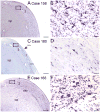Laminar and neurochemical organization of the dorsal cochlear nucleus of the human, monkey, cat, and rodents
- PMID: 25132345
- PMCID: PMC4170232
- DOI: 10.1002/ar.23000
Laminar and neurochemical organization of the dorsal cochlear nucleus of the human, monkey, cat, and rodents
Abstract
The dorsal cochlear nucleus (DCN) is a brainstem structure that receives input from the auditory nerve. Many studies in a diversity of species have shown that the DCN has a laminar organization and identifiable neuron types with predictable synaptic relations to each other. In contrast, studies on the human DCN have found a less distinct laminar organization and fewer cell types, although there has been disagreement among studies in how to characterize laminar organization and which of the cell types identified in other animals are also present in humans. We have reexamined DCN organization in the human using immunohistochemistry to analyze the expression of several proteins that have been useful in delineating the neurochemical organization of other brainstem structures in humans: nonphosphorylated neurofilament protein (NPNFP), nitric oxide synthase (nNOS), and three calcium-binding proteins. The results for humans suggest a laminar organization with only two layers, and the presence of large projection neurons that are enriched in NPNFP. We did not observe evidence in humans of the inhibitory interneurons that have been described in the cat and rodent DCN. To compare humans and other animals directly we used immunohistochemistry to examine the DCN in the macaque monkey, the cat, and three rodents. We found similarities between macaque monkey and human in the expression of NPNFP and nNOS, and unexpected differences among species in the patterns of expression of the calcium-binding proteins.
Keywords: auditory system; brainstem; cochlea; hair cells; tinnitus.
© 2014 Wiley Periodicals, Inc.
Figures










References
-
- Adams JC. Neuronal morphology in the human cochlear nucleus. Arch Otolaryngol Head Neck Surg. 1986;112:1253–1261. - PubMed
-
- Adams JC, Warr WB. Origins of axons in the cat’s acoustic striae determined by injection of horseradish peroxidase into severed tracts. J Comp Neurol. 1976;170:107–121. - PubMed
-
- André VM, Cepeda C, Vinters HV, Huynh M, Mathern GW, Levine MS. Pyramidal cell responses to gamma-aminobutyric acid differ in type I and type II cortical dysplasia. J Neurosci Res. 2008;86:3151–3162. - PubMed
-
- Arai R, Winsky L, Arai M, Jacobowitz DM. Immunohistochemical localization of calretinin in the rat hindbrain. J Comp Neurol. 1991;310:21–44. - PubMed
Publication types
MeSH terms
Substances
Grants and funding
LinkOut - more resources
Full Text Sources
Other Literature Sources
Miscellaneous

